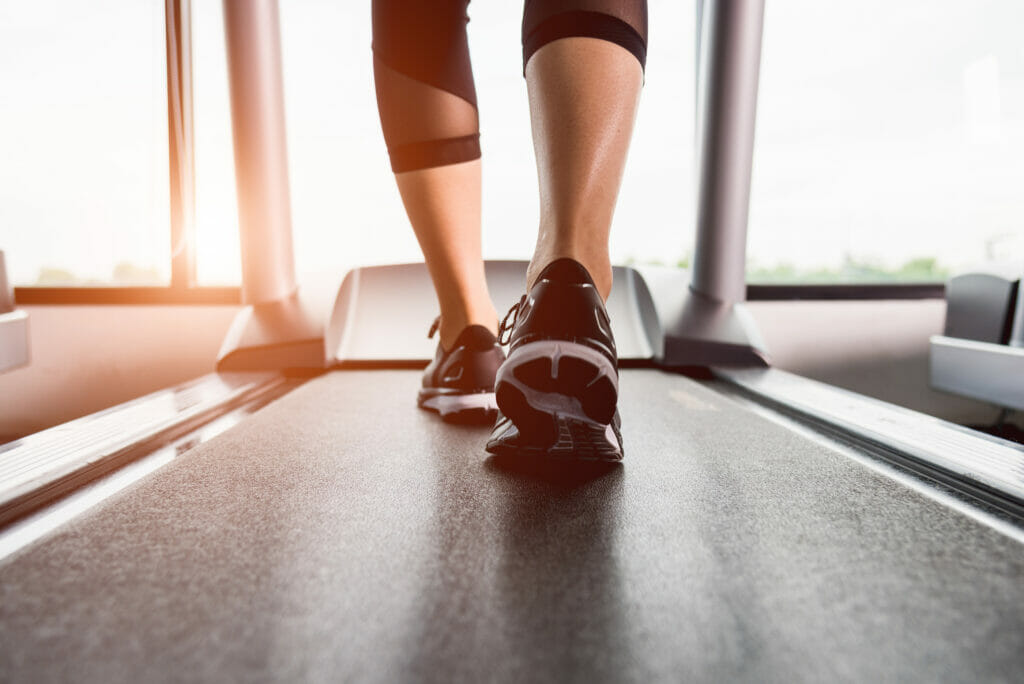
If you’re in the market for a new home treadmill, Sole’s F63 and F80 are both great choices. Each comes with a strong motor, heavy-duty components, and a great warranty.
Basically, the F63 and the F80 are both top models in their respective price ranges.
But with a difference of roughly $700, give or take, there is a big difference in price between these treadmills.
So, are the upgrades found on the F80 enough to warrant the extra investment?
Well, these are the questions I hope to help you answer.
In this head-to-head comparison, I’ll go over all the most important performance specs and features each treadmill has to offer.
And don’t worry, I’ll make sure to point out the most prominent differences between these treadmills, as well as provide my 2 cents regarding which treadmill makes more sense.
After reading, you’ll know which one of these impressive treadmills is best suited for your home gym.
With a larger running surface, stronger motor, longer warranty, and much nicer console, the F80 makes more sense for folks looking for a higher-performing machine with more tech features. The F63 would be a good choice for users who won’t be doing as intense workouts and who wouldn’t miss the built-in apps.
| Sole F63 | Sole F80 | |
| Running surface | 20″ x 60″ | 22″ x 60″ |
| Motor | 3.0 HP 0 – 12 mph 15 levels incline | 3.5 HP 0 – 12 mph 15 levels incline |
| Rollers | 2.36″/1.8″ | 2.36″ |
| Dimensions | 77″ x 35″ x 67″ | 82.5″ x 38″ x 66″ |
| Weight limit | 325 lb | 350 lb |
| Console | 6.5″ LCD | 10.1″ touchscreen |
| Warranty | Lifetime frame/motor 2 year parts 1 year labor | Lifetime frame/motor 3 year parts 1 year labor |
| Price | ~$1100 | ~$1800 |
Sole’s F63 vs The F80
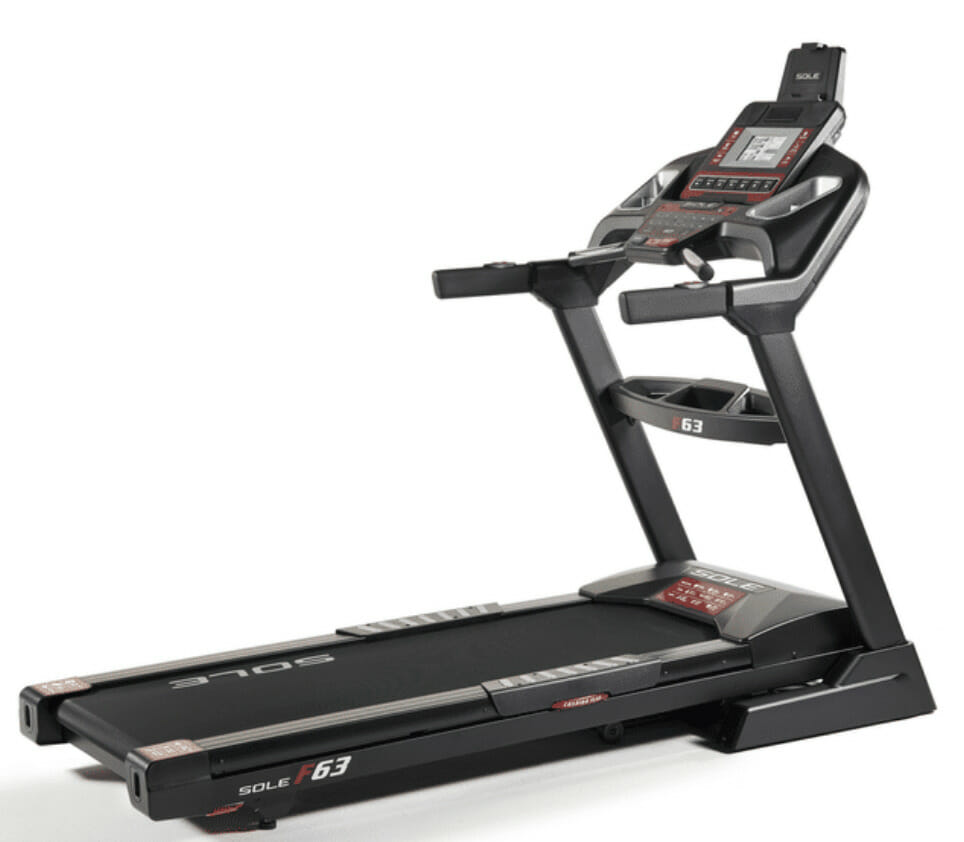
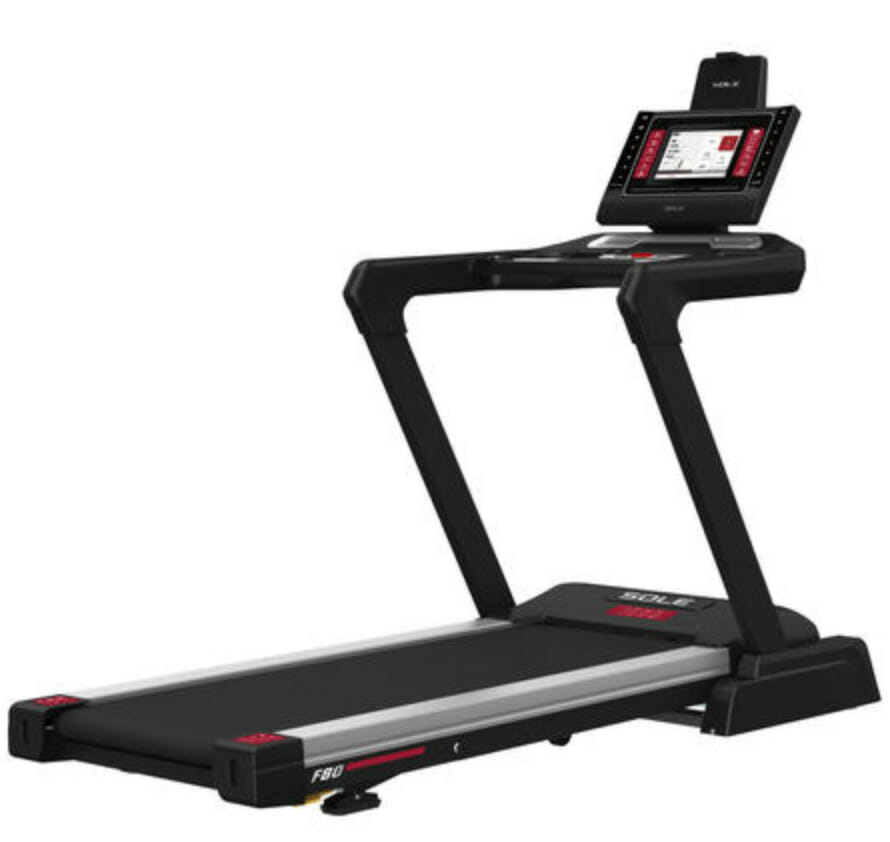
You really can’t go wrong with Sole.
Whether you’re looking for a treadmill, elliptical, or exercise bike, Sole should be one of the first brands you consider.
As a brand, they’ve earned a stellar reputation for providing high quality products, but I like them because their machines are easy to use and built for performance over anything else.
They also offer some of the best warranties on the market.
I would consider Sole a moderately priced brand – most of their products cost somewhere between $1000 – $2500.
When it comes to treadmills, this brand has 6 to choose from with the F63 being their most affordable model to date (with a sales price right around $1100).
The F80 is one of their mid-range models and usually costs somewhere around $1800.
When comparing these 2 treadmills (or any of Sole’s other models), there are a few specs where you’ll see differences as you go up in price.
Although at first glance, these differences can sometimes seem fairly subtle.
These specs include the running surface, motor strength, roller size, and weight capacity.
You’ll notice these are all performance specs.
The consoles on Sole’s treadmills are mostly pretty similar, although the size will very a little depending on the model (but more on that in a bit).
Since the above specs are where we see the biggest differences, I figure it makes sense to start with these.
P.S.- if you’d like to see a comparison of all Sole’s current models, check out my complete Sole treadmill guide for more info.
Running Surface
I think the running surface should be the first spec you consider when looking at any treadmill. In case you’re not familiar with the term, it simply refers to the size of the belt.
And although it might sound like a technicality, this spec tells you how much room you’re going to have during your workouts.
And whether you’re going to be comfortable or not.
When it comes to running surfaces, bigger is better- I mean I’ve never heard of anyone complaining that their treadmill is “too spacious”.
The gold standard for home treadmills is a running surface that measures 20″ x 60″ (width x length).
With a belt of this size, a treadmill is capable of comfortably fitting pretty much all users, regardless of how fast they run (we tend to increase our stride length when running at faster speeds).
Well, the F63 comes with a running surface of 20″ x 60, while the F80 comes with a slightly larger, 22″ x 60″ running surface.
An extra 2 inches of width doesn’t sound like much, and it certainly isn’t going to make or break your workout, but it’ll make for a more luxurious experience.
It’ll also make for a more commercial like experience, which is what we’re all looking for from our home treadmills anyway.
Motor Strength/Rollers
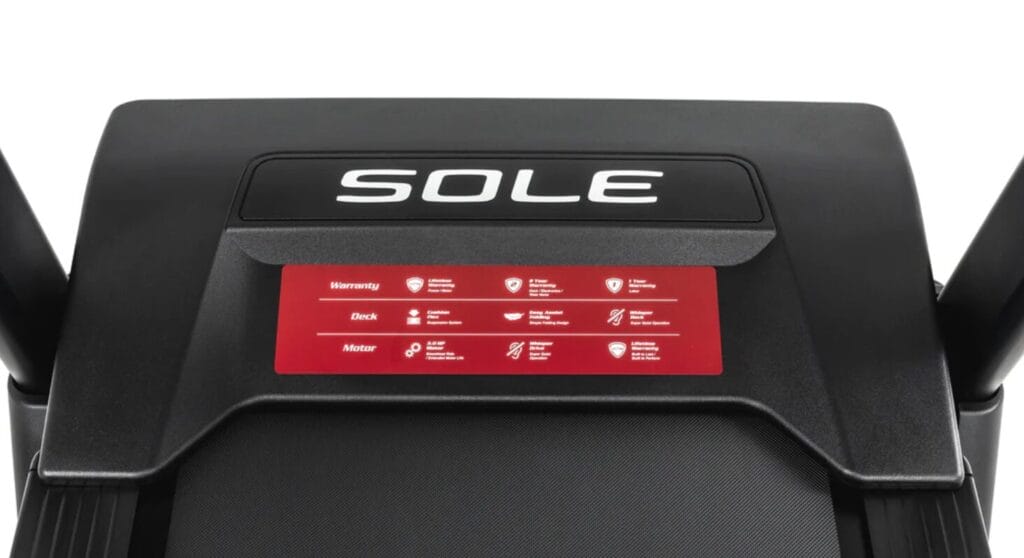
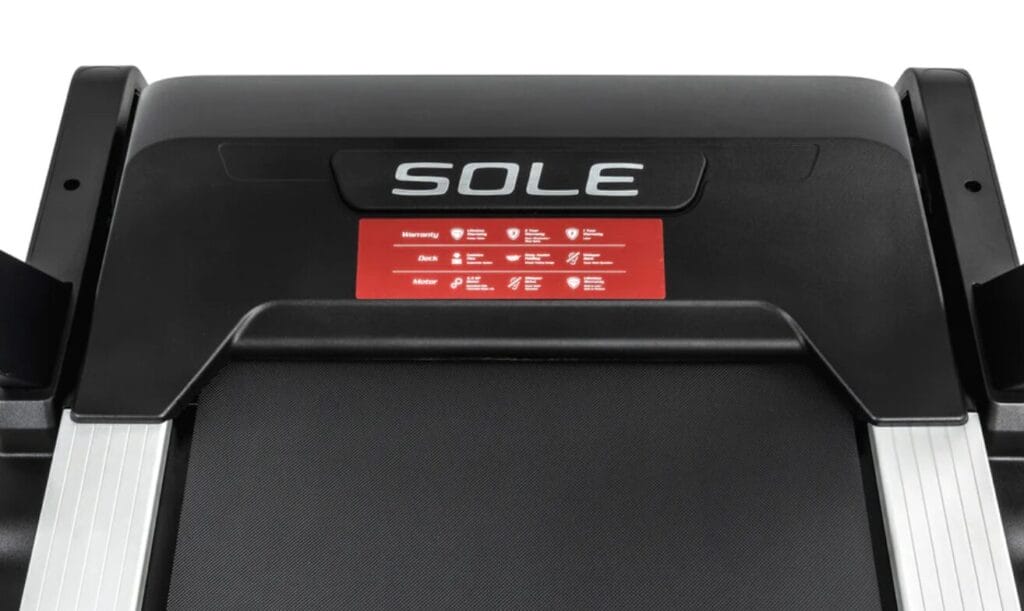
If the running surface is the first spec you should examine, the motor strength is a close second.
The motor is the heart of your treadmill and it’s responsible for powering every single workout you’ll ever do, regardless whether you’re walking or running.
I’m of the opinion that stronger is almost always better (I say “almost” because this might not necessarily be the case when comparing an AC motor to a DC motor, but most home treadmills use DC motors, so this is rarely an issue).
Anyway, having a stronger motor is beneficial because it means the motor won’t have to work as hard as a weaker one would to provide the same output.
This means the stronger motor is more efficient.
A stronger motor will run smoother and more quietly. And, since it isn’t having to work as hard, a stronger motor will usually last longer too.
I hope that all makes pretty good sense, but what exactly counts as a “strong” motor?
Great question.
If you’re planning on running on a regular basis, I suggest going for at least a 3.0 HP motor.
A treadmill with 3 horses under the hood should be strong enough to handle regular running workouts, but it would make sense for serious runners to go with an even stronger motor if their budget allows for it.
Again, motors have to work harder to reach and maintain faster running speeds- and a stronger motor will be able to handle that work more efficiently.
With all of that in mind, Sole’s F63 comes with a 3.0 HP motor, while the F80 comes with a 3.5 HP motor.
Both of these treadmills reach that 3 HP line in the sand I drew for being a good running treadmill, but with the extra horse power, the F80 will be better equipped to handle more serious runners.
Oh, I almost forgot about the rollers!
The rollers are the part of the treadmill that make contact with the belt and allow it to slide smoothly over the deck as the motor does its thing.
Rollers come in various sizes, but higher-end (and more expensive) treadmills usually come with larger rollers.
Having larger rollers is beneficial because they make more surface contact with the belt. This makes for smoother operation, but it also puts less stress on both the rollers and the belt.
Which extends the life of both.
And, having the belt moving more smoothly should even put less stress on the motor too.
Cheaper treadmills tend to come with rollers under 2″, while higher-end models come with rollers in the 2″ – 3″ range.
When we compare the rollers on these treadmills, we see a very subtle difference.
The F63 comes with 2.36″ front rollers and 1.8″ rear rollers, while the F80 both come with 2.36″ front and rear rollers.
So, both treadmills use the same size front rollers, but the F80 comes with larger rear rollers.
Honestly, this by itself isn’t a huge difference, but the larger rear rollers on the F80 do make for an overall heavier-duty machine.
Overall, the F80 comes with a larger motor and larger rear rollers.
Frames
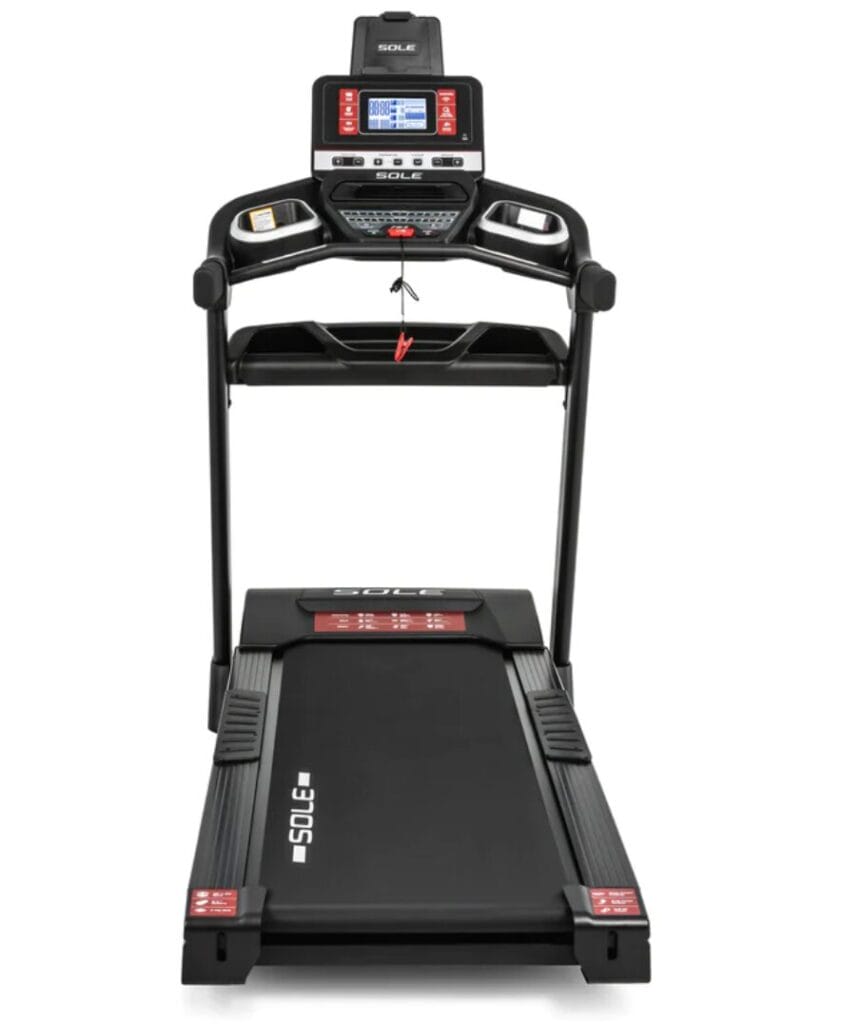
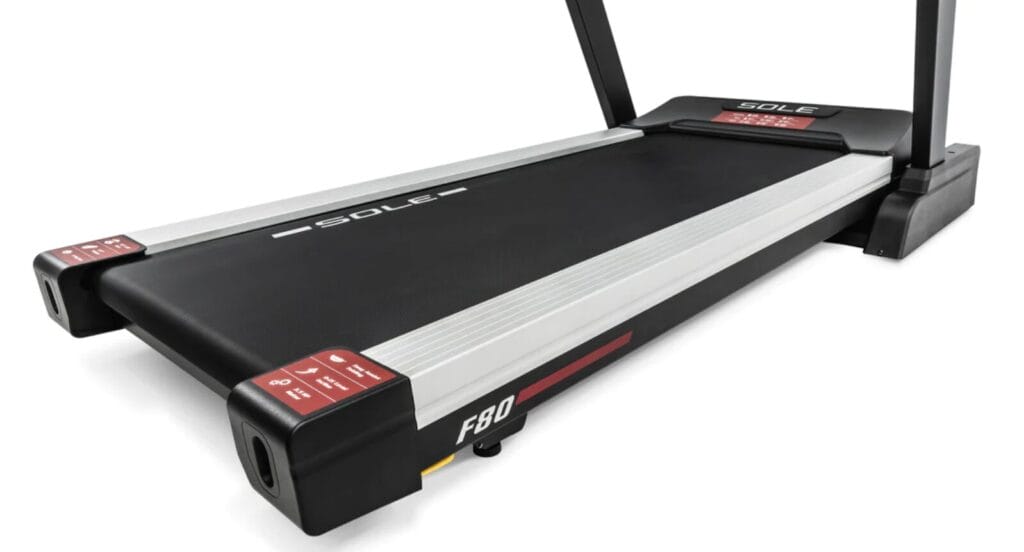
At first glance, you’ll notice the F63 comes with a standard frame design, while the F80 comes with an updated Z-shaped design (with regards to the uprights).
I don’t think this makes much structural difference, but it does give the F80 a more modern appearance.
More importantly, these treadmills come with the following dimensions (unfolded):
- Sole’s F63: 77″ x 35″ x 67″
- Sole’s F80: 82.5″ x 38″ x 66″
So, the F80 is almost 6″ longer than the F63, so if you’re worried about having enough room for your treadmill, this could be significant.
The F80 also weighs about 50 lb more than the F63 (274 lb assembled weight vs 224 lb), which is pretty significant too.
Personally, I like to see heavier treadmills because the extra weight will make for a more stable base during workouts.
With both of these treadmills weighing well over 200 lb, you shouldn’t have to worry about either feeling flimsy, but the F80 is definitely the heavier-duty model.
This is also evident when we compare the weight capacities of these two machines:
- Sole F63: 325 lb
- Sole F80: 350 lb
The F80 can hold larger users than the F63, which makes sense considering how much bigger and heavier it is.
On a side note, I like to see at least a 300 lb weight capacity for any piece of home fitness equipment I’m considering.
Both treadmills surpass this, but again, the F80 comes with an even higher weight limit.
Again, something larger users will want to consider when comparing these treadmills.
Oh, almost forgot – both treadmills fold vertically for storage as well.
Features
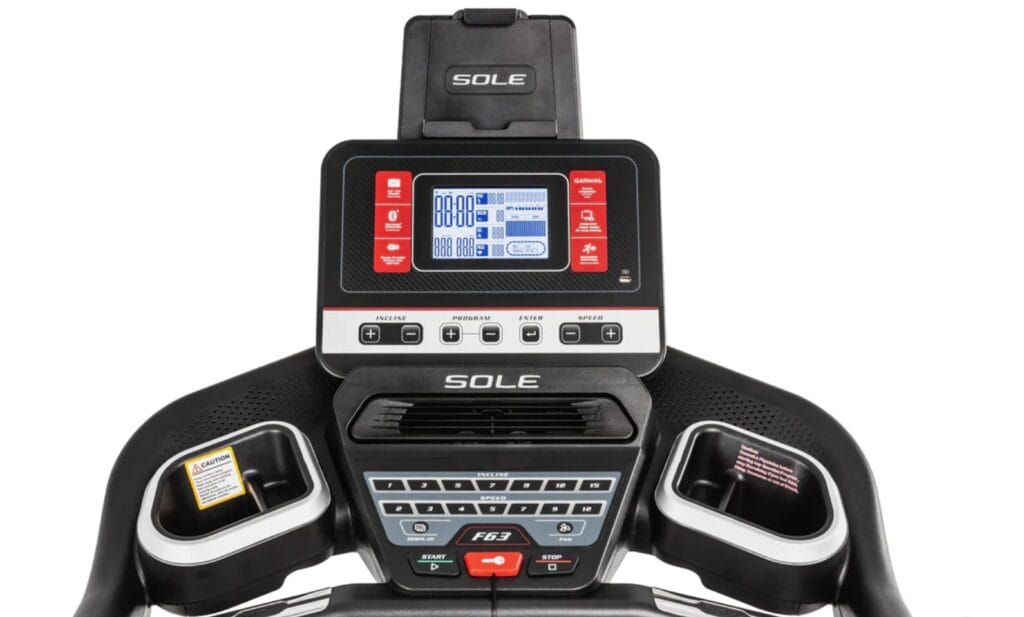
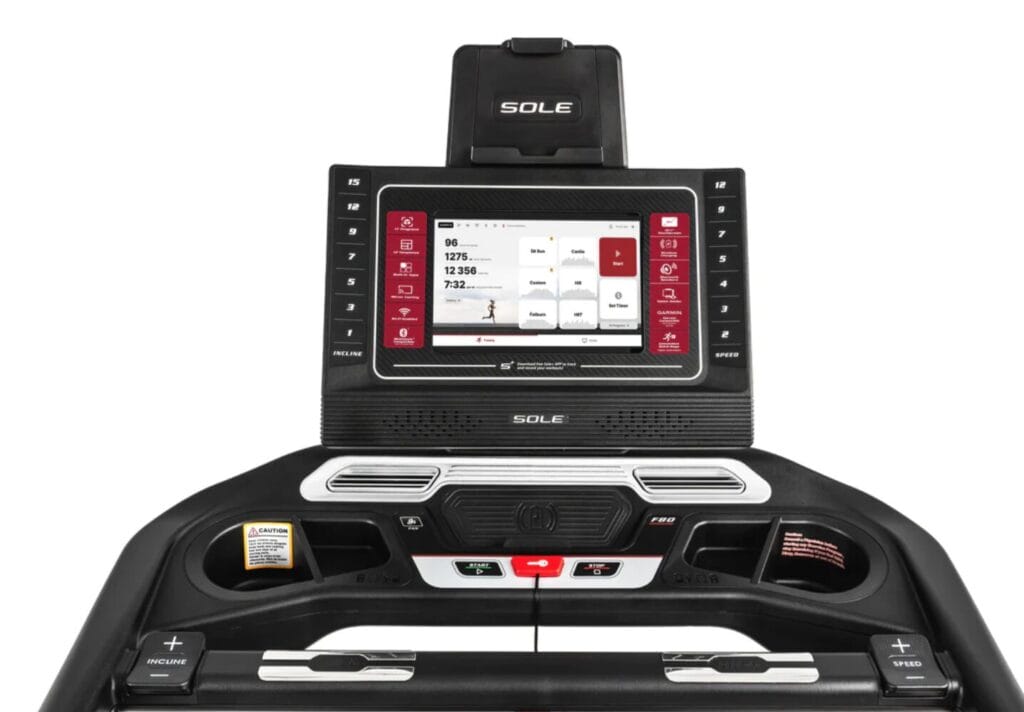
That about does it for the performance specs, so let’s switch gears and talk about features.
And there’s a big difference between the console features found on these treadmills.
| Sole F63 | Sole F80 | |
| Console | 6.5″ LCD | 10.1″ touchscreen |
| Entertainment apps | No | Yes |
| Sole+ | With phone/tablet | Built-in |
| Screen mirroring | No | Yes |
| Workout profiles | 7 + 2 custom | 10 + 12 custom |
| Bluetooth speakers | Yes | Yes |
| Charging | USB | Wireless |
| Fan | Yes | Yes |
| Tablet holder | Yes | Yes |
The F63 comes with a simple LCD console that includes 7 workout profiles and 2 custom workout options, as well as bluetooth speakers and USB charging.
The F63 is bluetooth compatible with Sole+ (Sole’s free streaming app that gives you access to instructor-led workouts), but you’d have to pair your phone or tablet with the treadmill.
The F63 also comes with a cooling fan, tablet holder, and water bottle holders, but that’s about it.
The F80 on the other hand, comes with an upgraded 10.1″ touchscreen that’s loaded with entertainment apps (Netflix, Prime, etc), more workout profiles (10 + 12 custom), screen mirroring, and has Sole+ built-in.
In other words, the F80’s console is pretty awesome.
The F80 also comes with an upgraded, wireless charging pad, so you don’t have to mess with having a USB cord connected to your treadmills.
Otherwise, the F80 comes with the same bluetooth speakers, fan, and tablet holder.
Overall, there’s a big difference between these consoles – the F80 comes with an updated touchscreen, while the F63 comes with the older, simpler LCD console.
Warranties
Sole backs the F63 and F80 with the following home warranties:
| Sole F63 | Sole F80 | |
| Frame | Lifetime | Lifetime |
| Motor | Lifetime | Lifetime |
| Parts | 2 years | 3 years |
| Labor | 1 year | 1 year |
Ok, both treadmills come with a great warranty and there’s not a huge difference between ’em.
Both treadmills come with lifetime frame/motor coverage, as well as a year for labor.
The only difference here is that the F80 comes with an additional year of parts coverage.
Overall though, I think both treadmills come with great warranties for their respective price ranges.
Final Thoughts
Ok, that about does it for the F63 and the F80.
I found it fun to write this comparison because I like to write about high quality products – and there’s really no debating that both of these models are top notch.
The F63 is easily one of the best budget treadmills on the planet and the F80 is easily one of the best treadmills under $2000.
If you’re on a tighter budget, it makes sense to go with the F63 because it’s a great treadmill in its own right, but if you have the option of stretching that budget a little further, you’ve got some thinking to do.
With the F80, we see several upgrades and when you add ’em all up, I think the additional cost is easily warranted.
When compared to the F63, the F80 comes with:
- a larger running surface
- a stronger motor
- larger rollers
- a heavier deck
- a higher weight capacity
- a much nicer console
- a longer warranty
Basically, the F80 is a more powerful and sophisticated treadmill.
If you’re stuck between these 2 models, think about what type of workouts you’ll be doing and how many people will likely be using it in your home.
If you’re planning on doing a lot of running, it makes sense to go with the F80, with its larger running surface and stronger motor.
If you’re planning on mostly walking or jogging, the F63 will likely do just fine.
If multiple family members will be using your treadmill regularly, it also makes sense to go with the heavier-duty F80 because it’ll be better equipped to handle the extra stresses.
If you’ll be the only user and if you’re of smaller stature, the F63 should be able to handle ya just fine.
And of course, if you want the added luxury of a touchscreen console with built-in apps, the F80 obviously makes more sense.
Overall, Sole’s F63 and F80 are both great treadmills, but the F80 comes with several key upgrades that make it a good choice for serious runners and folks looking for more tech features.

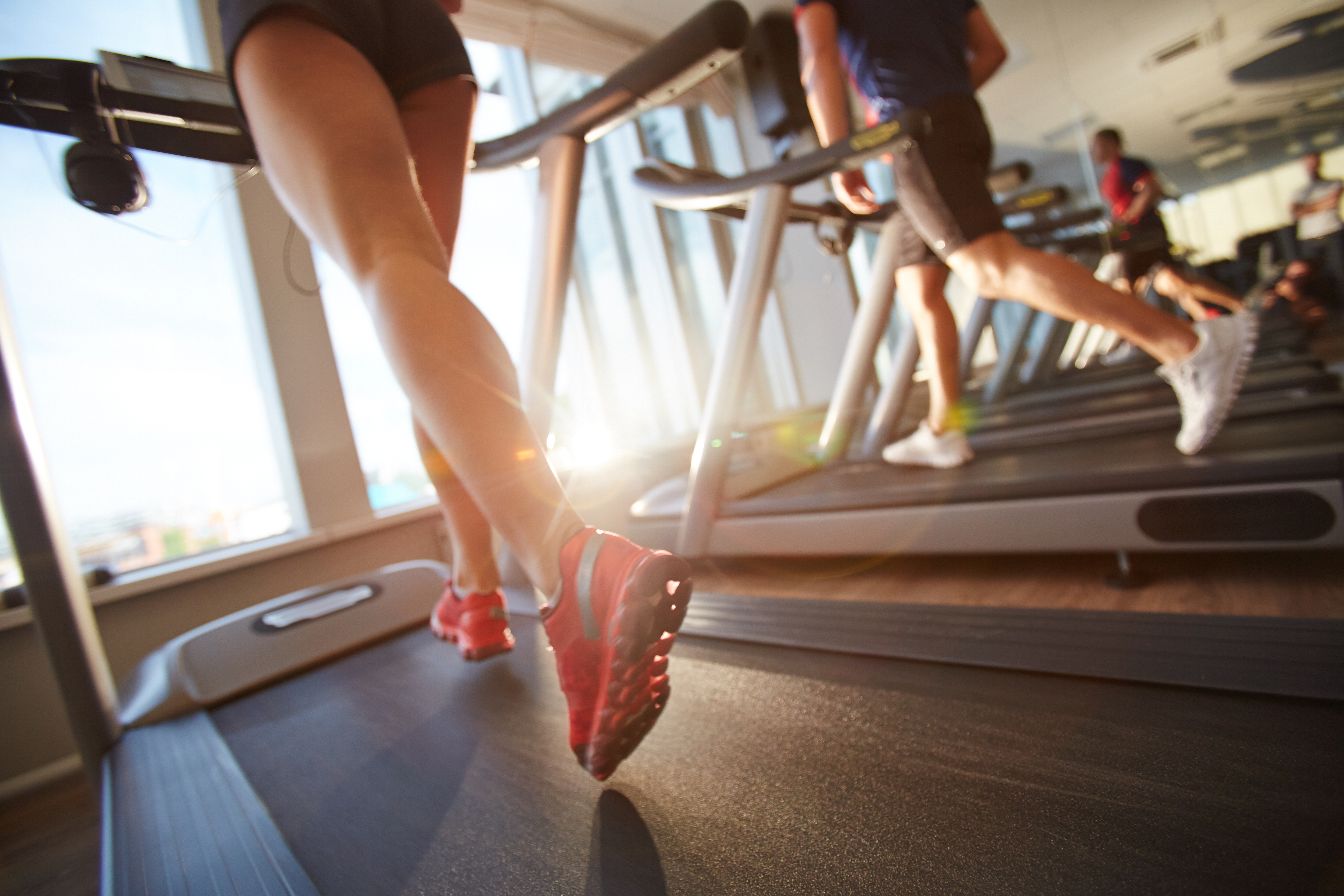


My wife (130lb) currently jogs 5mph for 30 min. I (215lb) jog at 5-6mph for 45min. Is the F63 good enough for us or should we go F80?
We currently have an old Epic View 550, probably 10 years old that we bought used. It has a 3.5HP motor.
I think the 3.0 mph motor on the F63 would be able to handle the running you and your wife are doing. The F63 is also a little smaller than the F80 (20″ width vs 22″), not a huge deal but something to consider as well – more of a comfort/preference thing. But in terms of motor strength, I think the F63 would be able to get the job done for ya.
Thanks for this comparison. It helped a ton!! I was leaning F80 and you just confirmed it. Thanks.
Awesome, glad you found it helpful. Thanks for reading!
Nicely done comparison!
Thanks for reading!